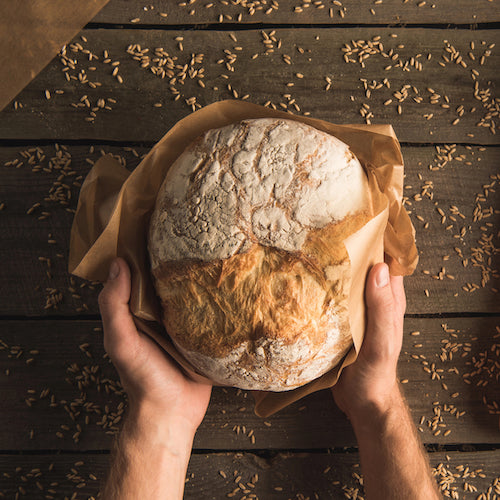Easy No-Knead Bread
Posted on July 08 2024
This is the easiest no-knead bread recipe that you'll ever make, from the book Mothers Little Helper. You can easily adapt it and make sourdough loaf by substituting the dried yeast for 1.5 cups of sourdough starter.
The best way to make this no-knead bread is to prepare it before you go to bed, let it sit all night, and then put it in the oven the next day in time to have fresh bread for lunch. When you take it out of the oven it will be crisp and crunchy, just like a loaf of bread you might buy in a French bakery.
If you'd like to make sourdough but don't have a starter, there's an amazing Facebook page on everything you need to know about fermenting; there's even a section under 'files' where you can find people who have a starter in your area (before you can contact anyone you have to join the page). Take a look at Fermenting Freaks Forever! New Zealand.
Easy No-Knead Bread 3 cups white flour (for wholemeal use 1 cup wholemeal flour and 2 cups white flour) ¼ tsp granulated yeast (or 1.5 cups sourdough starter) 1¼ tsp salt 1½ to 2½ cups of warm filtered water
Method Mix the flour, yeast and salt in a bowl. Pour the water in slowly and stir until you have a sticky — not stiff —dough. Sometimes I need just 1½ cups of warm water, at others I need the full 2 ½ - it depends on the flour you use and the climate. If you get a sloppy dough, don’t worry, it will still make great bread, it’ll just be a nightmare to work with. Cover with a tea towel and let it prove in a warm place for 12 to 24 hours. Leave it by the fire when you go to bed in the winter, or you could put it in a hot water cupboard or on top of your fridge, if you' d like a quicker solution you can stand the bowl in a larger bowl of boiling water and leave for several hours.
The dough is ready to use when you lift the tea towel and see the surface is dotted with bubbles. Don’t be alarmed if it looks like a sloppy batter; this is the way it should look.
Get lots of flour and sprinkle it on a work surface so that you have a thick covering. You don’t want to see any surface through the layer of flour. Tip the bread dough out onto the surface, sprinkle the top with lots more flour and fold it over on itself a few times so that it is a mound, then cover with a tea towel and leave for 15 minutes to recover. Do not be surprised if it starts expanding and creeping out onto the work surface during this time.
Flour your hands generously and shape the dough into a ball. Coat a tea-towel liberally with flour — again, you want a really thick covering and then put the ball of dough onto the tea towel and wrap loosely. Leave in a warm place for two hours so that it can double in size.
Half an hour before the dough is ready, put a 2-litre casserole pot or Dutch oven — I use a heavy cast-iron pot with lid — into a hot oven at 230 degrees C to heat up. When the dough is ready, take the pot out of the oven, put the bread into it and give it a shake to settle it into the pot. Place back in the oven with its lid on for 30 minutes, and then cook without the lid for another five minutes or so, until the loaf is nicely brown on top. Remove from the oven, inhale and enjoy.


